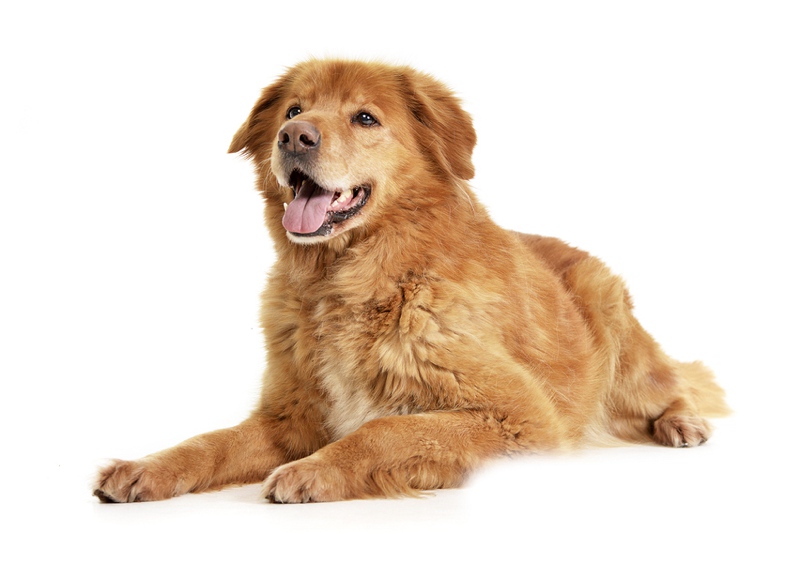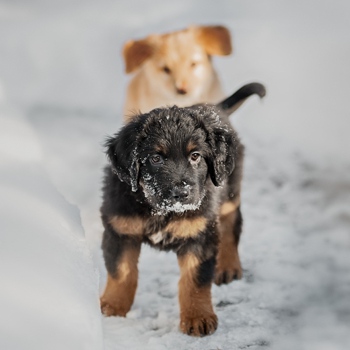Hovawart

The Hovawart is a powerful working dog of German origin with a long and noble history, first appearing in historical documents dating from 1210. Its name translates as “estate guardian”, and gives a clue as to its intended purpose. It is a calm and confident character that is reserved around strangers, and is ever watchful for danger. Indeed, such is its devotion to family that it will willingly put itself in danger for their protection, and it makes an excellent guard dog. While it is a relatively rare breed in the United Kingdom, it is employed by emergency services on the Continent as a search-and-rescue and tracking dog, and it enjoys having a job to do.
Hovawarts are strong-willed characters, and need a firm but loving owner who can handle their sometimes stubborn behaviour. The traits of protectiveness and suspicion of strangers can combine to create aggression if not properly managed, and these are dogs that need plenty of socialisation when young. They also have high energy levels, and need at least an hour of daily exercise, along with access to a good-sized garden. Their strong, potentially domineering personality means they do not always mix well with other dogs, and have the capacity to inflict serious injuries in a fight, so they are best suited to homes that do not have other pets. The breed is an extremely healthy one, with no recognised predispositions to illness, and has a life expectancy of around 11 to 13 years.
About & History
The Hovawart’s origins lie in the Black Forest region of southwest Germany, where it was originally bred to protect the local nobility and their property in the Middle Ages. Its place in German history was cemented in 1210, when the castle of Ordensritterburg was ransacked and its occupants slaughtered. The family’s Hovawart, itself injured, managed to rescue the lord’s infant son by dragging him from a burning building and bringing him to a neighbouring castle, thus exhibiting the selfless and protective nature of the breed at this very early stage. Later, in the fifteenth century, the Hovawart was used to track down criminals, as recorded in Heinrich Mynsinger’s “The Five Noble Breeds”. However, despite being a useful native breed, the Hovawart gradually fell from favour, being usurped by the likes of the German Shepherd, with the result that it was all but extinct by the early twentieth century.
In 1915, a group of enthusiasts led by the zoologist Dr. Kurt König set about resurrecting the breed, a process that was perhaps more a recreation than a rescue. The team scoured the Black Forest region for local dogs that fitted with historic accounts of the Hovawart, and crossed these with a range of other breeds, including the German Shepherd, Leonberger, Newfoundland, and even an African Hunting Dog, to produce a healthy breeding population. By 1937, the re-imagined Hovawart was standardised enough to be admitted to the German Kennel Club’s registry. It was quickly recognised for its utility, and large numbers of these dogs were drafted for military service in World War II, a fact that almost resulted in its quick demise. Few dogs survived the war, but those that did went on to slowly rebuild the population. The Hovawart first arrived in the United Kingdom in 1980, and was recognised by the Kennel Club two years later, but it has remained a rare breed in this country, with around two to three hundred individuals currently registered.
Appearance

The Hovawart is a large, well-built dog of slightly elongated shape, with the back being significantly longer than the height at the withers. It has a large, long head, with a broad, rounded skull and an obvious stop. The skull is approximately the same length as the muzzle, which is strong and tapers slightly along its length. It has tight lips and large teeth that may meet in either a scissor- or pincer-type bite. The eyes are oval-shaped and dark brown in colour, and the ears are set high and wide apart, making the powerful head appear even larger. They lie against the side of the head when relaxed, and can be raised to a semi-erect position, their tips drooping forward.
The Hovawart’s neck is moderately long, and it leads to the elongated back, which is straight and firm along its length. The croup slopes just slightly to the tail, which is bushy and long, almost reaching the ground when at rest. The chest is broad, deep, and long, and the abdomen has a barely perceptible tuck. While the forelimbs are upright in profile, the hindlimbs reflect the German Shepherd’s input to the breed, being markedly angulated, and there is strong bone structure throughout. The paws are round and compact, and the Hovawart moves with an extended stride, most of the drive coming from the rear.
The breed has a long, slightly wavy coat that lies close to the skin, with a thin undercoat. Fringing is obvious on the chest, abdomen, backs of the limbs, and tail. It may be one of three colour varieties:
- Black & Gold
- Black
- Blonde
There is marked sexual dimorphism, with males standing 63 to 70 cm tall and weighing 42–50 kg (92–110 lb), while females range in height from 58 to 65 cm and weigh 34–40 kg (75–88 lb).
Character & Temperament
Above all, the Hovawart exudes confidence and assuredness. It is neither a nervous nor aggressive dog, but is calm and even-tempered unless provoked. Its overriding concern is for its family’s safety, and this devotion stems from the strong bond it forms with its people. The naturally protective nature of the breed means it is watchful and considerate around children, and it is instinctively wary of strangers. This is not an ideal breed for the novice owner, as it has a strong personality, and is inclined to try to assume a dominant position in the family; something that needs to be prevented in order to maintain control over this powerful dog.
Owners need to be firm and confident in handling any challenging behaviour, particularly during the adolescent phase of the dog’s life. The Hovawart can be somewhat abrasive in its manner with other dogs, and inter-dog aggression is not an uncommon problem. While this may be ameliorated by socialisation training, the breed is best avoided by those with other dogs in the home. In addition, it does possess an instinct to hunt, meaning it should not be mixed with smaller pets.
Trainability

As a strong-willed and somewhat independent breed, the Hovawart is rarely blindly obedient, and unlike other working dogs, does not live to please. Instead, it thrives when it feels it is working in collaboration with, rather than for, its owners.
It is important to provide tangible rewards in the form of treats when training, and to avoid criticising the dog for failure to follow commands, as it will become more stubborn and sullen in the face of such treatment. Instead, whenever the Hovawart begins to lose interest, the owner should abandon the training session and begin again later.
Health
The Hovawart is remarkably healthy, it suffers no significant inherited illness, although joint problems, including those listed below, may be more common in certain families.
Cruciate Ligament Rupture
Some dogs are predisposed to injury of this vital structure, as they have an underlying inflammatory condition within their stifle (knee) joints. The ligament running between the bottom of the thigh bone and top of the shin that allows the joint to hinge while remaining stable is therefore weakened, and may rupture under minor stress. The result is a sudden onset of hindlimb lameness, and surgical repair of the ligament is necessary to prevent arthritis rapidly developing.
Hip Dysplasia
An often inherited developmental disorder affecting one or both hip joints. As a result, the ball and socket of the hip joint do not fit snugly, causing discomfort, lameness, and stiffness after rest. Signs are often first noticed in growing pups between 6 and 14 months of age. Adults should ideally be hip scored before being used for breeding to ensure they are not passing on defective genes to their offspring.
Exercise and Activity Levels
This is a highly energetic breed that needs plenty of exercise – an hour a day at a minimum. It is capable of a great deal more than this, and is an ideal jogging or hiking companion. Being a clever working dog, it will gain a great deal of satisfaction from competing in a range of canine sports, including tracking and agility trials. Its instinctive need to guard its territory means it should be given access to a good-sized garden during the day, though it should not be expected to spend large chunks of time alone outdoors.
Grooming
The Hovawart’s coat needs to be brushed twice weekly to remove loose hair and to prevent matting, but should only rarely need washing. It is left unclipped, so professional grooming is not required. The breed has thick, strong nails that will need occasional clipping – this practice, along with daily tooth brushing, should be introduced from a young age to ensure they are accepted by the dog when it is a large, powerful adult.
Famous Hovawarts
The Hovawart’s relative scarcity outside of Germany means it has remained under the radar of the general public and celebrities alike, and it has seldom made the headlines since its first appearance in the press 800 years ago.
Cross-Breeds
Though it is occasionally crossed with other large Germanic breeds, including the Rottweiler, the Hovawart does not produce any well-recognised cross-breeds at this time.

